最新汽车专业英语原文及翻译
- 格式:ppt
- 大小:1.49 MB
- 文档页数:61
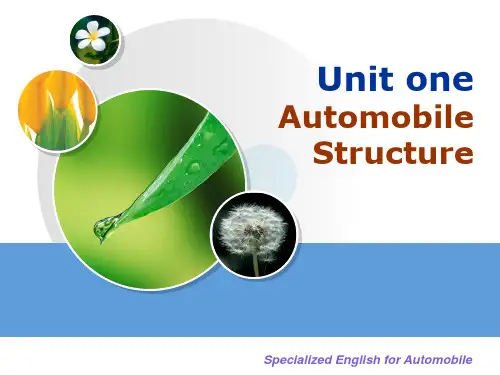
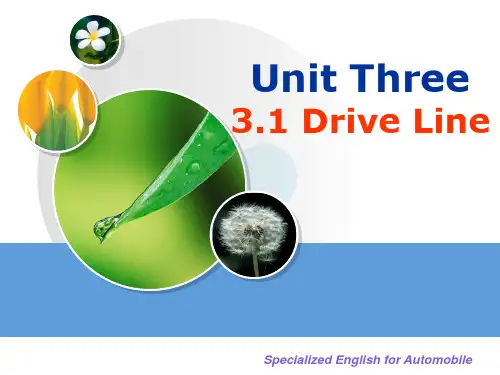
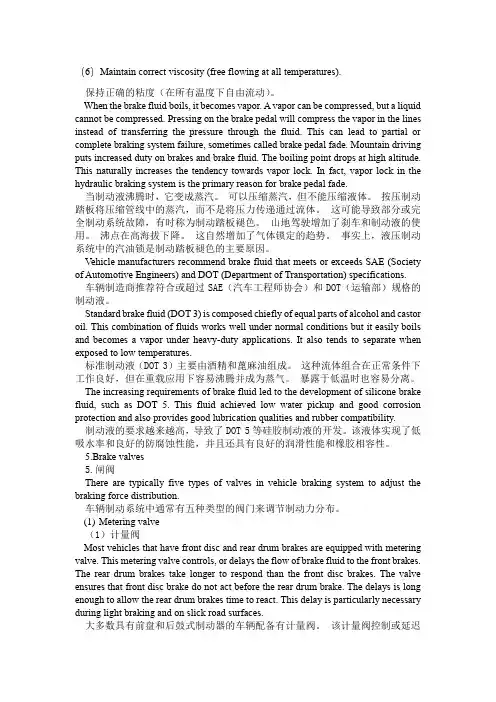
(6)Maintain correct viscosity (free flowing at all temperatures).保持正确的粘度(在所有温度下自由流动)。
When the brake fluid boils, it becomes vapor. A vapor can be compressed, but a liquid cannot be compressed. Pressing on the brake pedal will compress the vapor in the lines instead of transferring the pressure through the fluid. This can lead to partial or complete braking system failure, sometimes called brake pedal fade. Mountain driving puts increased duty on brakes and brake fluid. The boiling point drops at high altitude. This naturally increases the tendency towards vapor lock. In fact, vapor lock in the hydraulic braking system is the primary reason for brake pedal fade.当制动液沸腾时,它变成蒸汽。
可以压缩蒸汽,但不能压缩液体。
按压制动踏板将压缩管线中的蒸汽,而不是将压力传递通过流体。
这可能导致部分或完全制动系统故障,有时称为制动踏板褪色。
山地驾驶增加了刹车和制动液的使用。
沸点在高海拔下降。
这自然增加了气体锁定的趋势。
事实上,液压制动系统中的汽油锁是制动踏板褪色的主要原因。
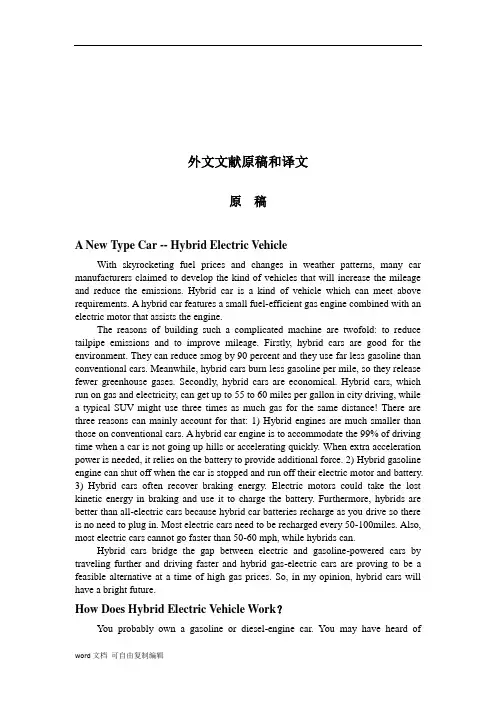
外文文献原稿和译文原稿A New Type Car -- Hybrid Electric VehicleWith skyrocketing fuel prices and changes in weather patterns, many car manufacturers claimed to develop the kind of vehicles that will increase the mileage and reduce the emissions. Hybrid car is a kind of vehicle which can meet above requirements. A hybrid car features a small fuel-efficient gas engine combined with an electric motor that assists the engine.The reasons of building such a complicated machine are twofold: to reduce tailpipe emissions and to improve mileage. Firstly, hybrid cars are good for the environment. They can reduce smog by 90 percent and they use far less gasoline than conventional cars. Meanwhile, hybrid cars burn less gasoline per mile, so they release fewer greenhouse gases. Secondly, hybrid cars are economical. Hybrid cars, which run on gas and electricity, can get up to 55 to 60 miles per gallon in city driving, while a typical SUV might use three times as much gas for the same distance! There are three reasons can mainly account for that: 1) Hybrid engines are much smaller than those on conventional cars. A hybrid car engine is to accommodate the 99% of driving time when a car is not going up hills or accelerating quickly. When extra acceleration power is needed, it relies on the battery to provide additional force. 2) Hybrid gasoline engine can shut off when the car is stopped and run off their electric motor and battery.3) Hybrid cars often recover braking energy. Electric motors could take the lost kinetic energy in braking and use it to charge the battery. Furthermore, hybrids are better than all-electric cars because hybrid car batteries recharge as you drive so there is no need to plug in. Most electric cars need to be recharged every 50-100miles. Also, most electric cars cannot go faster than 50-60 mph, while hybrids can.Hybrid cars bridge the gap between electric and gasoline-powered cars by traveling further and driving faster and hybrid gas-electric cars are proving to be a feasible alternative at a time of high gas prices. So, in my opinion, hybrid cars will have a bright future.How Does Hybrid Electric Vehicle Work?You probably own a gasoline or diesel-engine car. You may have heard ofelectric vehicles too. A hybrid vehicle or hybrid electric vehicle (HEV) is a combination of both. Hybrid vehicles utilize two or more sources of energy for propulsion. In the case of HEVs, a combustion engine and an electric motor are used.How it works depends on the type of drive train it has. A hybrid vehicle can either have a parallel or series or parallel-series drive train.Parallel HybridThe parallel hybrid car has a gas tank, a combustion engine, transmission, electric motor, and batteries.A parallel hybrid is designed to run directly from either the combustion engine or the electric motor. It can run using both the engine and the motor. As a conventional vehicle, the parallel hybrid draws its power from the combustion engine which will then drive the transmission that turns the wheels. If it is using the electric motor, the car draws its power from the batteries. The energy from the batteries will then power the electric motor that drives the transmission and turns the wheel.Both the combustion engine and the electric motor are used at the same time during quick acceleration, on steep ascend, or when either the engine or the motor needs additional boost.Since the engine is directly connected to the wheels in a parallel drive train, it eliminates the inefficiency of converting mechanical energy into electrical energy and back. This makes a very effective vehicle to drive on the highway.Series HybridThe series hybrid car also has a gas tank, a combustion engine, transmission, electric motor, and batteries with the addition of the generator. The generator can be the electric motor or it can be another separate component.The series configuration is the simplest among the 3. The engine is not connected to the transmission rather it is connected to the electric motor. This means that the transmission can be driven only by the electric motor which draws its energy from the battery pack, the engine or the generator.A hybrid car with a series drive train is more suited for city driving conditions since the engine will not be subjected to the varying speed demands (stop, go, and idle) that contributes to fuel consumption.Series-Parallel HybridThe series-parallel configuration solves the individual problems of the parallel and series hybrid. By combining the 2 designs, the transmission can be directly connected to the engine or can be separated for optimum fuel consumption. The Toyota Prius and the Ford Escape Hybrid use this technology.Honda’s hybridFor those of you who have toyed with the idea of buying a hybrid but were discouraged by the price, you are not alone. In fact, despite the growing concern for the environment, not to mention the skyrocketing price of gas, hybrid cars still only represent a small percentage of global car sales, and a major reason for this is the cost.Hybrids are considered the wave of the future because they not only reduce emissions, addressing the issue of climate change, but they get great gas mileage, animportant consideration with the current price of oil. It should be noted that hybrids can also improve the power of the engine, which compromises any advantages in fuel efficiency and emissions. Whatever the application, however, the technology makes the cars more expensive.Because of this, they are the vehicle of choice for only a small niche of people who can afford them, and they currently enjoy a special status amongst the image conscious celebrity-set. For most average consumers, however, they are not an option.That may soon change.Honda Motor Corporation, one of the largest car manufacturers in the world and a leader in fuel efficient technology, has unveiled it’s plan to introduce a low-cost hybrid by 2009. If they can pull it off, they hope to make the hybrid a more mainstream car that will be more appealing to the general public, with the ultimate goal of achieving greater sales and broader appeal than their current incarnation.This, of course, is making Detroit nervous, and may signal a need for American car makers to start making greener and more fuel efficient vehicles, something they could afford to ignore in the past because hybrid cars weren’t worth their attention (due to such a small market share) while gas-guzzling SUVs have such high profit margins.Honda, meanwhile, has had to confront a growing need to compete with Toyota, which has not only grown to be the world’s largest automaker, but makes the car that has become synonymous with the hybrid movement, the Prius. Honda is therefore faced with the seemingly insurmountable task of challenging Toyota’s dominance in the market.Concurrently, Toyota is racing to lower production costs on the Prius, as well, which would hopefully result in a lower cost to the consumer. All eyes are on a potentially favorable car buyers market in 2009.In the meantime, with even adamant global warming naysayers warming up (no pun intended) to the possibilities of an ecological disaster on the horizon, maybe it’s time that we got over our need to drive huge SUVs and start moderating our fuel consumption.Then again, as gas prices hovering around $4.00 and with no ceiling in sight, we may have little choice in the matter.Engine Operating PrinciplesMost automobile dngines are internal combustion, reciprocating 4-stroke gasoline engines, but other types have been used, including the diesel, the rotary ( Wankel ) , the 2-srtoke, and stratified charge.Reciprocating means up and down or banck and forth, It is the up and down action of a piston in the cylinder blick, or engine block. The blick is an iron or aluminum casting that contains engine cylinders and passges called water jackets for coolant circulation. The top of the block is covered with the cylinder head. Which forms the combustion chanber. The bottom of the block is covered with an oil pan or oil sump.Power is produced by the linear motion of a piston in a cylinder. However, this linear motion must be changed into rotary motion to turn the wheels of cars of trucks. The piston is attached to the top of a connecting rod by a pin, called a piston pin or wrist pin. The bottom of the connecting rod is attached to the crankshaft. The connecting rod transmits the up-and-down motion of the piston to the crankshaft, which changes it into rotary motion.The connecting rod is mounted on the crankshaft with large beaings called rod bearings. Similar bearings, called main bearings, are used to mount the crankshaft in the block. Shown in Fig. 1-1The diameter of the cylinder is called the engine bore. Displacement and compression ratio are two frequently used engine specifications. Displacement indicates engine size, and compression ratio compares the total cylinder volume to compression chamber volume.The term stroke is used to describe the movement of the iston within the cylinder, as well as the distance of piston travel. Depending on the type of engine the operating cycle may require either two or four strokes to complete. The 4-stroke engine is also called Otto cycle engine, in honor of the German engineer, Dr. Nikolaus Otto, who first applied the principle in 1876. In the 4-stroke engine, four strokes of the piston in the cylinder are required to complete one full operating cycle. Each stroke is named after the action it performs intake, compression, power, and exhaust in that order, shown in Fig1-2.1、Intake strokeAs the piston moves down, the vaporized mixture of fuel and air enters the cylinder through open intake valve. To obtain the maximum filling of the cylinder the intake valve opens about 10°before t.b.c., giving 20°overlap. The inlet valve remains open until some 50°after b.d.c. to take advantage of incoming mixture.2、 Compression strokeThe piston turns up, the intake valve closes, the mixture is compressed within the combustion chamber, while the pressure rise to about 1Mpa, depending on various factors including the compression ratio, throttle opening and engine speed. Near the top of the stroke the mixture is ignited by a spark which bridges the gap of the spark plug.3、 Power strokeThe expanding gases of combustion produces a rise in pressure of the gas to some 3.5Mpa, and the piston is forced down in the cylinder. The exhaust valve opens near the bottom of the stroke.4、Exhust strokeThe piston moves back up with the exhaust valve open some 50°before b.d.d., allowing the pressure within the cylinder to fall and to reduce ‘back’pressure on the piston during the exhaust stroke, and the burned gases are pushed out to prepare for the next intake stroke.The intake valve usually opens just before the exhaust stroke. This 4-stroke cycle is continuously repeared in every as long as the engineremains running.A 2-stroke engine also goes through four actions to complete one operatingcycle.However, the intake and the compression actions are combined in one seroke, and the power and exhaust actions are combined in the other stroke. The term2-stroke cycle or 2-stroke is preferred to the term 2-cycle, which is really not accurate.In automobile engines, all pistons are attached to a single crankshaft. The more cylinders an engine has, the more power strokes produced for cach revolution. This means that an 8-cylinder engine runs more smoothly bdcause the power atrokes are closer together in time and in degrees of engine rotation.The cylinders of multi-cylinder automotive engines arranged in one of three ways. 1、Inline engines use a single block of cylinder.Most 4-cylinder and any 6-cylinder engines are of this design. The cylinders do not have to be vertical. They can be inclined either side.2、V-type engines use two equal bands of cylinders, usually inclined 60degrees or 90degrees from the cach other. Most V-type engines have 6 or 8 cylinders, although V-4 and V-12 engines have been built.3、Horizontally opposed or pancake engines have two equal banks of cylinders 180degreeas apart. These space saving engine designs are often air-cooled, and are found in the Chevrolet Carvair, Porsches, Subaus, and V olkswagens. Subaus design is liquid cooled.Late-model V olkswagen vans use a liquid-cooled version of the air cooled VWhorizontally opposed engine.译文新型汽车----混合动力汽车在油价飞涨的今天,汽车制造商被要求发展一种排放低,行驶里程长的汽车。
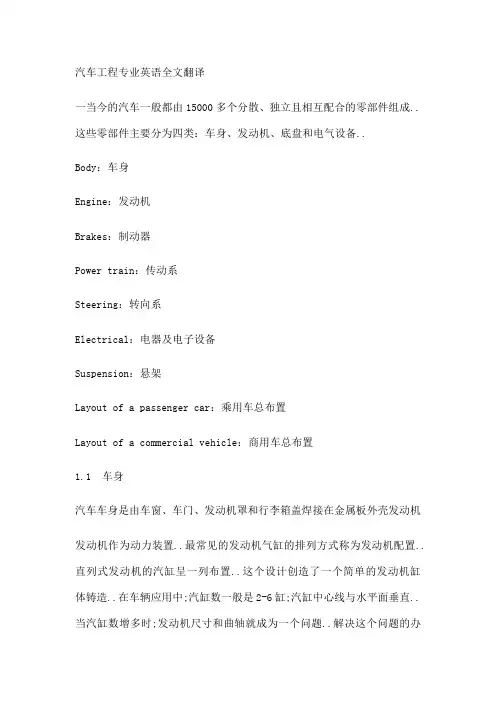
汽车工程专业英语全文翻译一当今的汽车一般都由15000多个分散、独立且相互配合的零部件组成..这些零部件主要分为四类:车身、发动机、底盘和电气设备..Body:车身Engine:发动机Brakes:制动器Power train:传动系Steering:转向系Electrical:电器及电子设备Suspension:悬架Layout of a passenger car:乘用车总布置Layout of a commercial vehicle:商用车总布置1.1 车身汽车车身是由车窗、车门、发动机罩和行李箱盖焊接在金属板外壳发动机发动机作为动力装置..最常见的发动机气缸的排列方式称为发动机配置..直列式发动机的汽缸呈一列布置..这个设计创造了一个简单的发动机缸体铸造..在车辆应用中;汽缸数一般是2-6缸;汽缸中心线与水平面垂直..当汽缸数增多时;发动机尺寸和曲轴就成为一个问题..解决这个问题的办法就是采用V形汽缸呈两列布置;且两列气缸之间夹角为V形发动机..这个设计使发动机尺寸和曲轴都变得更短且更坚硬.. 前置发动机纵向安装;既可前轮驱动也可后轮驱动..后置发动机是将发动机安装在后轮后面..发动机可横置或纵置;一般情况下为后轮驱动..1.4 电气系统电气系统为起动机、点火系统、照明灯具、取暖器提供电能..该电平由一个充电电路维护..1.4.1 充电充电系统为所有汽车电子元件提供电能..充电系统主要包括:蓄电池;交流发电机;电压调节器;即通常是交流发电机上不可或缺的;充电警告或指示灯和金属丝连成一个完整电路..蓄电池为起动提供电能;然后发动机工作;交流发电机就为所有的电子元件提供电能..同时也给蓄电池充电即用来使发动机起动..电压调节器有过充保护作用..1.4.2 起动起动系统包括:蓄电池、电缆、起动机、飞轮和换向器..起动时;有两个动作同时运行;该起动机齿轮与飞轮齿圈啮合;并起动电机;然后运行传输到发动机曲轴..起动机电机将起动机安装在发动机缸体上并由电池供电..1.4.3 点火一个基本的点火系统包括:蓄电池、低压电缆、点火线圈、线圈高压电缆、火花塞电缆和火花塞..点火系统提供高强度火花使火花塞点燃燃料室里的液体燃料..火花必须在适当的时候提供;并达到能够使燃料点燃的能量要求..这些能量从蓄电池和交流发电机获得;点火线圈使电压增高..该系统有两个电路;主电路或低压电路点燃火花;次电路或高压电路产生高压并将其分配到火花塞上.. 复习题1. 列出汽车有那几部分组成..2. 根据车身外形车辆常见类型是什么3. 向下移动的冰锥增加汽缸容积和新鲜的通过进气阀开启的空气燃料混合..2.压缩行程向上移动的活塞减少了汽缸内体积和压缩的空气燃料混合物..不久之前;香港贸易发展局是达成共识;火花塞点燃压缩空气燃料的混合物;从而启动了燃烧过程..更高的压缩比意味着更好的燃油利用率..压缩的程度受制于敲限制..3.做功行程火花点火后在火花塞点燃了压缩空气燃料的混合物;作为混合的结果温度升高..在汽缸增加;迫使活塞向下的压力..活塞转让的权力;通过连杆曲轴..4.排气行程向上移动的活塞燃烧排出的气体废气通过公开排气阀..在四冲程过完成后又周期重复..这台发动机有数以百计的其它部分..发动机的主要部件是发动机缸体;发动机头;活塞;连杆;曲轴和阀门..其他部分一起营造系统..这些系统是燃油系统;进气系统;点火系统;冷却系统;润滑系统和排气图2 - 2..这些系统都有一定的作用..这些系统将在后面详细讨论..发动机缸体是发动机的基本框架..所有其他发动机零件要么在其中的位置或固定它..其所持有的气瓶;水套和油画廊图2 - 4..发动机缸体还持有曲轴;那拴到块的底部..还装在凸轮轴块;除却架空凸轮OHC发动机..在大多数汽车;这个部件是由灰铸铁或者一种合金混合物灰铁和其它金属如镍或铬..发动机缸体是铸件..有些气缸体;特别是在小汽车里的那些;都是由铝做成的..这种金属比铁轻得多;然而;铁的耐磨性比铝好..因此;在大多数铝制发动机的气缸活塞;连杆和曲轴2.3.1 曲柄机构和能量活塞由曲柄机构和气缸;连杆组成..这些部件通过气体能量推动;从而引起这些部件产生惯性力..气能产生的力可以再细分为垂直于竖直平面的力Fn;且作用于汽缸壁;和一个推动连杆的力Fs;这个连杆的力;从而引起切向力Ft并作用于曲柄机构;这些能量要求在一起产生扭转和法向力Fr..这气体作用力分为作用角α;支点于连杆的作用角β;和压缩比入:连杆作用力: Fs=Fg/cosβ侧向力 : Fn=Fgtanβ法向力 : Fr=Fgcosα+β/ cosβ切向力 : Ft=Fg sinα+β/ cosβ所以的这些关系代表了一种方法计算各部件的振动.活塞是四个运动周期中一个重要部分;很多活塞都是从铝中提炼出来研制而成的.活塞;通过连杆传递能量来压缩点燃混合气体.这些能力转化为曲柄的动能.这样;圆形的钢圈装入汽缸;用活塞环来密封整个燃烧室.这个称为活塞环..这些用来放活塞环的称为凹槽..一个活塞销放在中间通过一个小孔固定..活塞销的作用是固定活塞于连杆之间的连接;对活塞销起作用的是活塞销凸台..活塞本身;它的环和活塞销一起称为活塞总成..1活塞为了抵抗高温的燃烧室;活塞必须非常坚固;但是也必须轻便;因为它是在气缸内高速运转而上下运动的;活塞内是空的;在顶部是厚的用来传递高温高压的气体动力;底部温度较低所以做成薄的..顶部是活塞头或活塞顶;薄部分是裙部;两节之间的凹槽称为环带..活塞顶可以是平的;凹的;圆顶的或是隐蔽的;在柴油机的燃烧可能形成完全或部分活塞冠;依靠这种方法喷射..所以活塞采用不同的形状..2..活塞环如图2-9所示;活塞环装进接近活塞顶部的环槽..简单来说;活塞环是薄的;是圆形的金属片;适合槽活塞顶部的..现在的发动机;每个活塞有三个活塞环;老式的发动机有四个甚至五个..活塞环装在活塞内表面的凹槽内..活塞环的外表面紧靠着汽缸壁活塞环提供了活塞环于汽缸壁之间的密封;也就是说;只有活塞环接触汽缸壁..顶头两个活塞环是防止气体从汽缸壁漏出的;称为压缩环..最底下的一个是防止汽油飞溅到缸桶而从间隙进入到燃烧室;所以称为油环..表面镀铬的铸铁压缩环一般用于汽车的发动机..镀铬的活塞环提供了光滑;耐磨的表面..在做功行程;燃烧室对压缩环的压力是非常大的..原因是他们朝汽缸壁方向挤开;一些高压的气体进入到活塞环;这样使得活塞环表面充分接触到汽缸壁;燃烧的气体压力使得活塞环底部紧紧地压住活塞凹槽;然而;越高的燃烧的气体压力更加紧紧地把活塞环表面和汽缸壁密封住.. 3..活塞销活塞销是用来连接活塞于连杆的..活塞销装入销孔;装入连杆最顶头的小孔..连杆的顶部应远小于连杆的尾部才能装进曲柄轴颈..小的底部装进活塞的内底部..活塞销通过一边装入活塞销;通过小的连杆一端;然后通过活塞的另一边..这使得连杆稳固地在活塞中间适当的位置..活塞销是是空心的且是高强度的钢制成的..很多销的镀铬的使得更加耐磨..连杆是高强度的钢铸造的;它通过曲柄轴颈传递力和运动从活塞到曲柄销..连杆小的一头是连接活塞销的..轴瓦是用软金属制成的;比如青铜;用来这样合成的..下级的连杆装进曲柄轴颈..这称为大头..这个轴承;是钢背的铅或者是锡壳制成的..这些是一样被用作主要轴承..大端的分离切口往往是单个的;所以它足够小可以从燃烧室中取出.. 连杆由合金钢铸成..曲轴如图2-10所示;连同连杆通过旋转而带动活塞往复运动从而带动汽车行驶..它是由碳钢和低比例的镍合成的主要的曲轴轴颈装进汽缸;大端匹配连杆..在曲轴的后端附加有飞轮;在曲轴的前端有驱动轮对应的正时齿轮;风扇;冷却水和发电机..曲轴的摆幅;i;e;是主要的轴颈和大端中心之间的距离..控制冲程的幅度;冲程是双次进行的;摆动的幅度是活塞从TDC到BDC的距离;反之亦然..单缸的发动机每两次曲轴循环只能提供单一的能量脉冲..能量只能提供四分之一的时间..当超过一个汽缸时它能从曲轴获得流动性的能量..额外的能量被均匀地隔开遍及两个转数或四冲程的一个周期..四缸的一般用于汽车..为了保持曲轴的平衡设置第一和第四的活塞是在TDC..第二和第三的活塞是在BDC每个冲程的间隔是180°;图标的序列显示了各个缸的点火顺序;点火顺序是1-3-4-2;但是这个顺序可以改变为1-2-4-3;如果安装了另外的凸轮轴.. 注意到第四个活塞总是伴随着第一活塞进行的..当第四活塞进气阀完全打开时;第一缸的活塞完全关闭;这是用来调节气门间隙的..表格飞轮有碳钢制成;装在曲轴的后端..同时带动曲轴旋转和离合器..同时传送给变速器;和启动齿圈包围着在四个冲程当中只有一个冲程是做功的所以飞轮只有在这个时间带动曲轴;发动机在这几个不做功的冲程转动..平衡器和减震器是用来保持发动机曲轴正常缓冲的..比如每个燃烧室燃烧;它能加快曲轴旋转..轴的惯性它稍稍随后;这样在曲轴上起扭转作用..连续扭转震动引起的频率不同于发动机的转速和发动机缸数..减震器减少他们的振动..减震器主要由轮毂和惯性环组成..惯性环是结合轮毂通过弹性插入的..惯性环转动是和曲轴密切相关的在燃烧室内;然而抑制其扭转;并通过曲轴控制犯低级转速..一些减震器是由两个惯性环和而且是不同的尺寸从而更好地控制其振动..使用了一段时间后;弹性体会恶化或连接件可以不要..致使减震器失效或是引起自身振动.. 损坏的必须得替换下来..减震器的设计要结合轮毂的密封轴颈..在轮毂里密封凹槽;造成石油泄漏..袖套修理可以恢复减震器如果是在良好的条件下..轮毂在一定条件下可以维修来调节衬套..2.6.1 汽油汽油是从原油中提炼石油..汽油是高度易燃的;这意味着它容易在空气容易燃烧..汽油容易蒸发..这种特性被称为波动;是重要的..但是;它不能太容易挥发;否则将转向油箱内的蒸汽..管内的燃料;燃料蒸气可能阻止液体汽油流..这就是所谓的蒸气锁..在燃料蒸气锁普遍在暴露于高温线泵的进口侧..汽油的燃烧;随其质量和添加剂比例混合的..汽油的燃烧方式在室燃烧是很重要的.增加燃烧室中的燃料混合物点火前的压力;有助于提高发动机功率..这是通过压缩到一个较小的燃料混合物体积..高压缩比;不仅有利于推力;而且也给更多的有效的动力..但更进一步的压缩比起来;敲倾向增加..辛烷值是对汽油的抗爆性的质量或在燃烧过程中能够抵抗爆炸的认定..有时被称为爆震敲质量或能力抵御爆炸..爆轰;有时也被称为敲门;作为燃料的燃烧空气的混合物;由于温度过高;在燃烧室内的压力条件的最后一个部分失控爆炸的定义..由于爆炸产生的压力波冲击;因此产生敲缸声;燃料燃烧和空气的混合物的扩张;导致丧失权力;局部温度过高;如果足够严重;引擎损害..有两种常用的汽油辛烷值测定的的方法马达法和研究方法..两者都使用的实验室相同的类型单缸发动机来做实验;这是一个头部和一个变量来表示敲缸爆震强度装置..作为燃料使用;发动机压缩比和空气燃料混合料试验样品进行了调整;试验出爆震强度..两个主要标准参考燃料;正庚烷和异辛烷;任意分配0和10辛烷值;然后分别是混合产生测试样品相同的爆震强度..因此百分比异辛烷的混合被认为是测试样品辛烷值;因此;如果相应的参考配方是由15%正庚烷和85%异辛烷;测试样品的额定电机向上或85研究法辛烷值;依据测试的一种方法..2.6.2完全燃烧汽油;是在理想条件下汽油在混合气中完全燃烧汽油所需要空气和汽油是15比1..这意味着1公斤汽油混合15公斤空气..汽油完全燃烧所需的空气被称为化学正确的混合物.. 15:1的比例适用于汽油;其他燃料有不同的比率.为了表示更实际;空气燃料混合物提供给空气燃料比14.7:1气缸偏离理论上完全燃烧所需;多余的空气因子R已被选定引擎:=空气质量提供/理论要求R为1 空气质量提供相应数额的理论的必要..<“1 空气或缺乏丰富的混合物..增加电力的射程R = 0.85 0.95输出结果..> 1.3 该混合物是如此精简的点火更长发生..精益失火超限.. = 0.95 0.85 火花点火发动机开发在5% 15%空气不足的最大功率.. = 1.1 1.2 发生在最大的燃油经济性高达20%左右的过剩空气..为R≈1.0 这种过剩空气系数允许与化学计量比空转..= 0.85 0.75 良好的转换发生15% 25%的空气不足..转型是指从一个给定的负载范围在实践中;过剩空气因素的R = 0.9 1.1已被证明是最实用的..在一定的操作条件下;燃料需求不同的混合模式于基本注入燃料的数量大于干预必需的. 冷启动在冷启动时;空气燃料混合物的发动机制定的加浓了..这是由于在起动速度低如果混合物燃油与空气粒子流动速度;并以最小的燃油蒸发和汽缸壁和进气口;在低温下润湿燃料..为了弥补这些现象;从而促进ID的冷发动机;注入更多的燃料才更容易起动..1.后启动阶段在低温起动后;必须加浓的一段短时期的混合物;以补偿较浠混合气的形成和摄入量与燃料缸..此外;在高扭矩;为更好的油门响应更加丰富的混合物时;加速从闲置的结果..2.热机预热阶段遵循冷启动阶段..该发动机的燃料需要;因为凝结一些仍然在寒冷的汽缸壁的热身阶段额外的燃料..在低温时;混合物的形成是由于较浓的大型燃料液滴的加入;由于与拟定的发动机在空气中混合燃料效率下降..其结果是;在进气阀门和进气歧管;只有在较高温度下燃油蒸发浓缩.. 上述因素均随温度降低必要的加浓的混合物.3.加速度如果油门突然被打开;空气燃料混合物瞬间倾斜过;以及混合浓缩短期在部分负荷运行;实现最大的燃油经济性和排放值是观察的关键因素.. 5.全负荷该引擎提供了在满负荷最大功率;当空气燃料混合比;必须加以丰富;在部分负荷..这种丰富依赖于发动机转速和提供最大的在整个发动机转速范围内尽可能的扭矩..这也确保在满负荷运行最佳燃油经济性的数字..6.怠速除了发动机的效率;发动机怠速主要决定于闲置的燃料消耗;在发动机冷高摩阻力;必须通过提高空气燃油混合输入克服..为了实现平稳运行在空闲;空闲速度控制怠速提高..这也导致了更快速热身的发动机..闭环闲置速度控制功能可以防止怠速过高..该混合物的数量相对应维持在有关的负载如冷发动机;并增加摩擦怠速所需要的数量..它还允许一个没有长期闲置的调整不断废气排放值..闭环闲置速度控制还部分地弥补在发动机老化带来的变化;并确保稳定的发动机整个使用寿命空转..7.空载减速时切断燃油降低燃油消耗不仅是长下坡运行和制动过程中;而且在城市交通..由于没有燃料完全燃烧;减少废气排放..8.发动机限速当发动机转速达到预设;教统会抑制燃油喷射脉冲..9..的空气燃料混合物在高海拔适应在高海拔地区的空气密度低就必须更精简的空气燃料混合物..在高海拔地区;由于较低的空气密度;容积流量的空气流量传感器对应一个较低的空气质量流量测量..这个错误可以弥补纠正的燃料数量..过度富集是可以避免的;因此;过多的燃料消耗..正如图2 - 20所示;燃料系统有一个油箱;油管;燃油泵;燃油滤清器和化油器..这零部件商店汽油;并提供给需要的化油器..简而言之;油箱储存汽油..行携带的燃料从油箱的燃料化油器..移动汽油燃油泵从油箱的燃料;并通过线化油器..燃料过滤器除去杂质的汽油..然后;化油器发送燃料的空气和汽油的混合物 - 进入燃烧室..1..燃油泵大多数车今天使用一个机械式燃油泵..这种燃料泵出了汽油;并通过油管向化油器或喷射系统..在大多数汽车;泵安装在发动机缸体..有些汽车电动燃油泵有一个..该泵安装在皮卡与燃料和燃料轨;发送单元油箱..对机械燃油泵操作取决于对凸轮轴叶..作者:爱在旋转移动泵摇臂..泵内;可以灵活的隔膜通过膜片弹簧摇臂;拉杆和链接..如图所示;燃油泵也有一个入口和燃料出口..由于凸轮轴上的旋转叶;横膈膜上下移动内部的引擎..隔膜的吸向下运动从进入泵油箱..隔膜向上运动推到了化油器;从泵的燃料..2..化油器化油器提供燃料比例的空气量流经喉管..当你在加速器踏板时;扩大开放节流阀吸引更多的空气通过化油器..化油器提供这取决于许多因素更丰富或更精简的混合物:发动机转速;负荷;温度;节气门位置..为了满足复杂的要求;一化油器是一个非常复杂的设备与许多内部通道及零部件.1喉管汽车化油器的设计是由喉管..喉管简直是气道狭窄的部分..空气通过化油器的喉咙;因为它移动的速度通过这个狭窄通道的旅行..通过建立合资企业增加的空气速度在喷嘴打开一个低压区..推动在一个大气压下水库内燃料的化油器浮子室称为..燃料是强行通过一根管子到空气流..2浮子室浮子室是一个储存和供应燃料的化油器水库..由于发动机使用的燃料;它会自动浮子室补充..浮动室内乐作品在同一作为一个抽水马桶水箱控股的基本原则..阿浮有赖于在水库燃料的顶部..作为燃料使用时;浮球液位下降..当浮动滴;一针阀打开..开放式针形阀允许从燃料的燃料泵入化油器的浮子室流..当商会是满了;针形阀是向上推;并关闭燃油进口..3测量燃油浮子室之间的压差和造成的燃料流..然而;为了维持适当的空气燃料比;化油器必须仅提供适量的燃料..为此;主放电管有一个小孔称为喷射或主射流..这允许燃料进入气流..在大多数情况下;这个小口子浮子室是在主放油管的末端..在那里;它的体积小燃油流量限制..4需要冷启动安排切断阀通过一个手段扼杀供气提供了丰富的混合物约8:1;并提供了一个轻松的粒子蒸发足够的引擎..5慢速贯穿化油器的空气量过小的时候;发动机只运行缓慢产生非常小的扼流圈抑郁症..这意味着太少将提供燃料和发动机将停止..缓慢运行的系统已经在这个区域里存在着抑郁症的高当发动机空转的电源插座..调节螺钉控制系统运行缓慢;一个螺丝设置空转速度运行缓慢等使混合物是让发动机转速平稳.. 6油门机制机制的油门控制空气燃料混合物流动..油门有几个;包括油门轴和节流板的一部分..通过打开和关闭;节气门控制的空气进入发动机燃料混合物流动..在诸如开放更多的空气流动;少的板关闭的气流..这些变化也气流控制汽油流..增加气流意味着更大的压力下降;从而更多的燃料流..气流减少意味着减少压降和流量较少的燃料..该议案的节流轴转动油门板..油门轴电缆连接到油门;反过来;连接到车内的油门踏板..司机控制空气燃料混合物踏板流动..2.6.5 莫特郎尼克点火和燃油喷射系统化油器将准确的空气燃料混合气发送到发动机..然而;并非所有的汽车都有化油器..许多现代汽车是用燃油喷射系统图2 - 22..燃油喷射系统与化油器式有许多优势..例如;它们能提供更多的精确控制..它们能够更好地匹配空燃比在不断变化的发动机状态..它们还提供更好的经济性和排放控制..此外;燃油喷射系统不需要化油器多余的那部分..该系统是一个莫特郎尼克发动机管理系统;包括控制单元ECU;它执行至少两个基本功能点火和喷油;但可能包含其他子系统需要改进的发动机控制1..测量值的检测气缸内的燃烧过程不仅受混合气和空气燃料比的影响;而且还受点火提前点火和点火火花的能源影响..一个优化的引擎控制;因此必须控制在整个喷射时刻的空气燃料比R A即喷入的燃油量;以及点火提前角α和持续角B..影响燃烧过程中的主要参数检测为测量值和一起处理瞬间发动机运行工况点火和喷射的最佳时机的计算..2..工作变量/传感器发动机转速和负荷是主要的工作变量..由于特定的点火提前角和精确的喷射时间对应于每个发动机的转速/负载地图点;重要的是所有的变量;其中涉及到同一个点都在相同的速度/负载面积计算..这不仅是可能的;如果点火提前和喷射时间以同样的速度和负载值发动机转速检测只有一次使用相同的传感器计算..这就避免了统计误差;可导致不同的负载传感器设备公差;例如;..而一个略有杆负荷范围不同的分配限制敲到发动机爆震的易感性增加..清除点火时间角和注射时间分配是由莫特郎尼克系统提供动力;即使在发动机运行条件下;3..莫特郎尼克系统该莫特郎尼克系统包括一系列子系统;两个基本子系统点火和喷油..综合后的系统更加灵活;可实现比相应的各个系统的功能更多..莫特郎尼克系统的重要特点是其作为一个最子功能所需的大量可自由编程实现地图..废气再循环EGR的功能至今尚未在欧洲使用;因此提供一种替代系统的唯一..控制系统的lambda只能算是今天;如果配合使用为减少尾统开环控制功能以及一个扩展的系统与闭环功能结合敲和lambda控制在管理系统气。
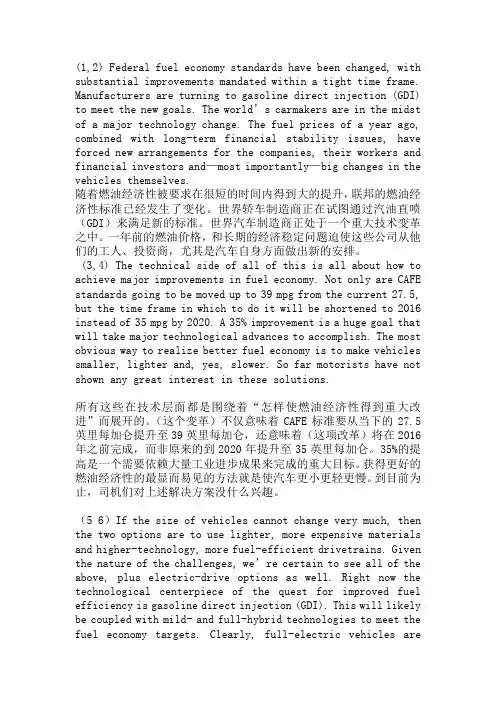
(1,2) Federal fuel economy standards have been changed, with substantial improvements mandated within a tight time frame. Manufacturers are turning to gasoline direct injection (GDI) to meet the new goals. The world’s carmakers are in the midst of a major technology change. The fuel prices of a year ago, combined with long-term financial stability issues, have forced new arrangements for the companies, their workers and financial investors and—most importantly—big changes in the vehicles themselves.随着燃油经济性被要求在很短的时间内得到大的提升,联邦的燃油经济性标准已经发生了变化。
世界轿车制造商正在试图通过汽油直喷(GDI)来满足新的标准。
世界汽车制造商正处于一个重大技术变革之中。
一年前的燃油价格,和长期的经济稳定问题迫使这些公司从他们的工人、投资商,尤其是汽车自身方面做出新的安排。
(3,4) The technical side of all of this is all about how to achieve major improvements in fuel economy. Not only are CAFE standards going to be moved up to 39 mpg from the current 27.5, but the time frame in which to do it will be shortened to 2016 instead of 35 mpg by 2020. A 35% improvement is a huge goal that will take major technological advances to accomplish. The most obvious way to realize better fuel economy is to make vehicles smaller, lighter and, yes, slower. So far motorists have not shown any great interest in these solutions.所有这些在技术层面都是围绕着“怎样使燃油经济性得到重大改进”而展开的。
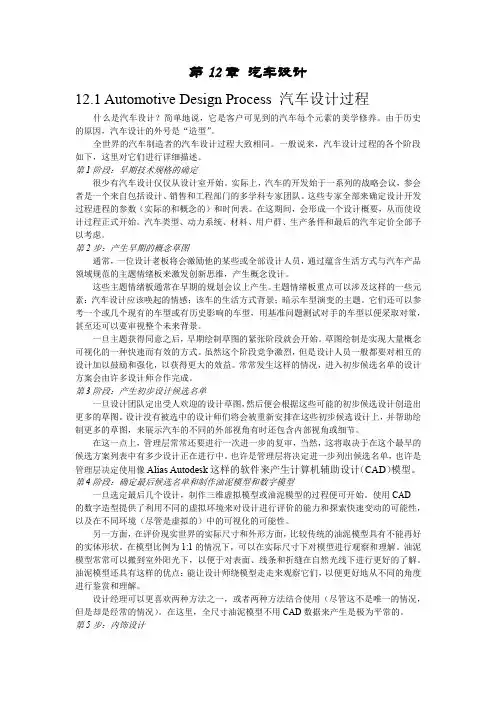
第12章汽车设计12.1 Automotive Design Process 汽车设计过程什么是汽车设计?简单地说,它是客户可见到的汽车每个元素的美学修养。
由于历史的原因,汽车设计的外号是“造型”。
全世界的汽车制造者的汽车设计过程大致相同。
一般说来,汽车设计过程的各个阶段如下,这里对它们进行详细描述。
第1阶段:早期技术规格的确定很少有汽车设计仅仅从设计室开始。
实际上,汽车的开发始于一系列的战略会议,参会者是一个来自包括设计、销售和工程部门的多学科专家团队。
这些专家全部来确定设计开发过程进程的参数(实际的和概念的)和时间表。
在这期间,会形成一个设计概要,从而使设计过程正式开始。
汽车类型、动力系统、材料、用户群、生产条件和最后的汽车定价全部予以考虑。
第2步:产生早期的概念草图通常,一位设计老板将会激励他的某些或全部设计人员,通过蕴含生活方式与汽车产品领域规范的主题情绪板来激发创新思维,产生概念设计。
这些主题情绪板通常在早期的规划会议上产生。
主题情绪板重点可以涉及这样的一些元素:汽车设计应该唤起的情感;该车的生活方式背景;暗示车型演变的主题。
它们还可以参考一个或几个现有的车型或有历史影响的车型,用基准问题测试对手的车型以便采取对策,甚至还可以要审视整个未来背景。
一旦主题获得同意之后,早期绘制草图的紧张阶段就会开始。
草图绘制是实现大量概念可视化的一种快速而有效的方式。
虽然这个阶段竞争激烈,但是设计人员一般都要对相互的设计加以鼓励和强化,以获得更大的效益。
常常发生这样的情况,进入初步候选名单的设计方案会由许多设计师合作完成。
第3阶段:产生初步设计候选名单一旦设计团队定出受人欢迎的设计草图,然后便会根据这些可能的初步候选设计创造出更多的草图。
设计没有被选中的设计师们将会被重新安排在这些初步候选设计上,并帮助绘制更多的草图,来展示汽车的不同的外部视角有时还包含内部视角或细节。
在这一点上,管理层常常还要进行一次进一步的复审,当然,这将取决于在这个最早的候选方案列表中有多少设计正在进行中。
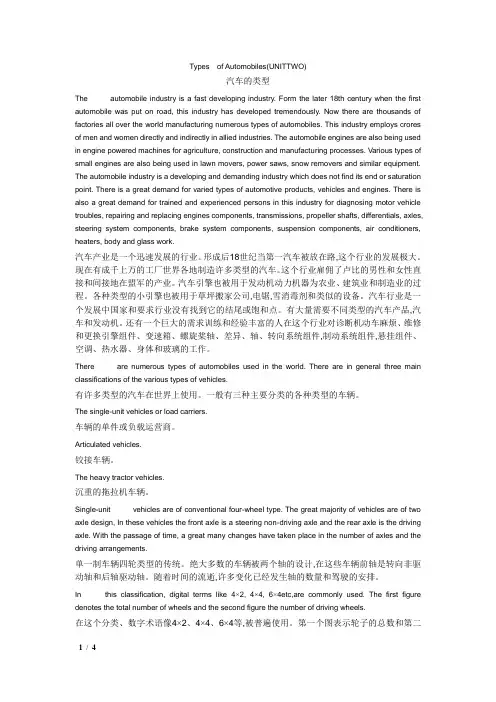
Types of Automobiles(UNITTWO)汽车的类型The automobile industry is a fast developing industry. Form the later 18th century when the first automobile was put on road, this industry has developed tremendously. Now there are thousands of factories all over the world manufacturing numerous types of automobiles. This industry employs crores of men and women directly and indirectly in allied industries. The automobile engines are also being used in engine powered machines for agriculture, construction and manufacturing processes. Various types of small engines are also being used in lawn movers, power saws, snow removers and similar equipment. The automobile industry is a developing and demanding industry which does not find its end or saturation point. There is a great demand for varied types of automotive products, vehicles and engines. There is also a great demand for trained and experienced persons in this industry for diagnosing motor vehicle troubles, repairing and replacing engines components, transmissions, propeller shafts, differentials, axles, steering system components, brake system components, suspension components, air conditioners, heaters, body and glass work.汽车产业是一个迅速发展的行业。
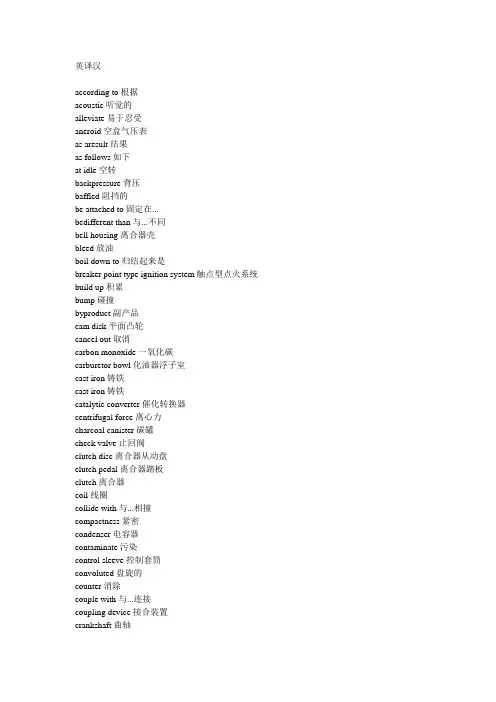
英译汉according to根据acoustic听觉的alleviate易于忍受aneroid空盒气压表as aresult结果as follows如下at idle空转backpressure背压baffled阻挡的be attached to固定在...bedifferent than与...不同bell housing离合器壳bleed放油boil down to归结起来是breaker point type ignition system触点型点火系统build up积累bump碰撞byproduct副产品cam disk平面凸轮cancel out取消carbon monoxide一氧化碳carburetor bowl化油器浮子室cast iron铸铁cast iron铸铁catalytic converter催化转换器centrifugal force离心力charcoal canister碳罐check valve止回阀clutch disc离合器从动盘clutch pedal离合器踏板clutch离合器coil线圈collide with与...相撞compactness紧密condenser电容器contaminate污染control sleeve控制套筒convoluted盘旋的counter消除couple with与...连接coupling device接合装置crankshaft曲轴cross-section横截面delivery valve出油阀diaphragm spring膜片弹簧discrete独立的distributor rotor分火头distributorless ignition system无分电器点火系统distributor分电器diverter valve换向阀drive shaft传动轴drive shaft传动轴drive train传动系effective stroke有效行程electric pump电动燃油泵engage with与...啮合Exhaust Gas Re-circulation(EGR)废气再循环feedback反馈fiberglass玻璃纤维figure数字flat平面flywheel飞轮fuel feed pump输油泵fuel pressure regulator燃油压力调节器fuel rail油轨fulcrum ring导轴衬gas mileage燃油经济性gas pedal加速踏板gear ratio传动比gearbox变速器get up to达到given给定的governor调速器groove沟gulp valve补气阀hall effect sensor霍尔效应传感器hanger吊钩header集气管high tension lead高压导线hinder阻碍hydrocarbon碳氢化合物in detail详细地injector喷油器injector喷油器inline pump直列式喷油泵interpolate内插leftmost最左边的lever杆listens for等着听little or no几乎没有magnetic field磁场manifold歧管manually手动地master cylinder主缸measure off量出meter计量momentarily瞬时地mount安放muffler消声器nitrogen oxides氮氧化合物nothing more than只不过是one-way clutch单向离合器out of phase with与...反相palladium钯PCV=positive crankcase ventilation 曲轴强制通风perforated多孔的phosphorus磷pinion gear小齿轮pivot支点platinum铂plunger barrel柱塞套pre-chamber预燃室pressure plate压盘prevailing主要的primary and secondary circuit初级电路和次级电路pulse width脉冲宽度pump泵轮redirect使改道relay继电器release bearing分离轴承release fork分离拨叉retract缩回return line回油管路rhodium铑ring gear齿圈room空间saturation磁饱和sensor传感器series串联sizable相当大的sludge油泥socket插座solenoid电磁线圈solid state pressure transducer晶体管压力传感器spark plug火花塞speaker扬声器spigot连接管接合spill port溢流口splined hub花键毂stall 停转stall停转stand for代表...stationary静止的stator导轮stepper motor步进电机stick out伸出sulfur dioxide二氧化硫tailpipe尾管taper off逐渐减少telemetry遥测技术tend to必然term学期the body of a car车身the moment一...就throttle body assembly节气门体总成thrust pad止推垫torque converter液力变矩器torsionary扭转的transformer变压器translation移动tremendous巨大的tricky复杂的turbine涡轮turn匝数vane pump叶片式泵wear磨损wind缠绕。
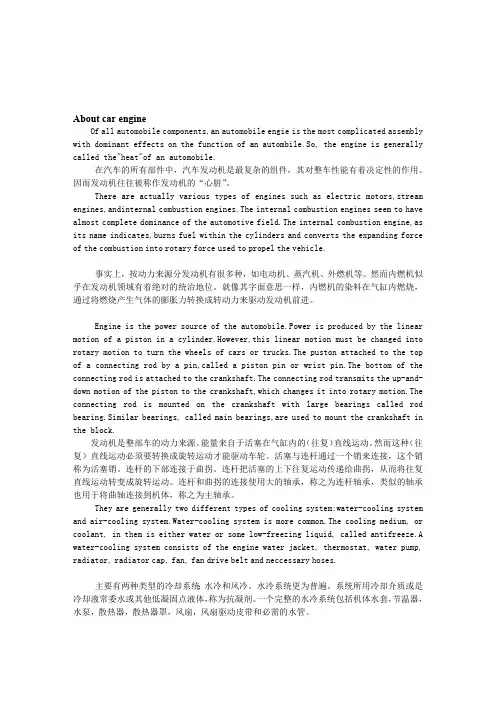
About car engineOf all automobile components,an automobile engie is the most complicated assembly with dominant effects on the function of an autombile.So, the engine is generally called the"heat"of an automobile.在汽车的所有部件中,汽车发动机是最复杂的组件,其对整车性能有着决定性的作用。
因而发动机往往被称作发动机的“心脏”。
There are actually various types of engines such as electric motors,stream engines,andinternal combustion engines.The internal combustion engines seem to have almost complete dominance of the automotive field.The internal combustion engine,as its name indicates,burns fuel within the cylinders and converts the expanding force of the combustion into rotary force used to propel the vehicle.事实上,按动力来源分发动机有很多种,如电动机、蒸汽机、外燃机等。
然而内燃机似乎在发动机领域有着绝对的统治地位。
就像其字面意思一样,内燃机的染料在气缸内燃烧,通过将燃烧产生气体的膨胀力转换成转动力来驱动发动机前进。
Engine is the power source of the automobile.Power is produced by the linear motion of a piston in a cylinder.However,this linear motion must be changed into rotary motion to turn the wheels of cars or trucks.The puston attached to the top of a connecting rod by a pin,called a piston pin or wrist pin.The bottom of the connecting rod is attached to the crankshaft.The connecting rod transmits the up-and-down motion of the piston to the crankshaft,which changes it into rotary motion.The connecting rod is mounted on the crankshaft with large bearings called rod bearing.Similar bearings, called main bearings,are used to mount the crankshaft in the block.发动机是整部车的动力来源。
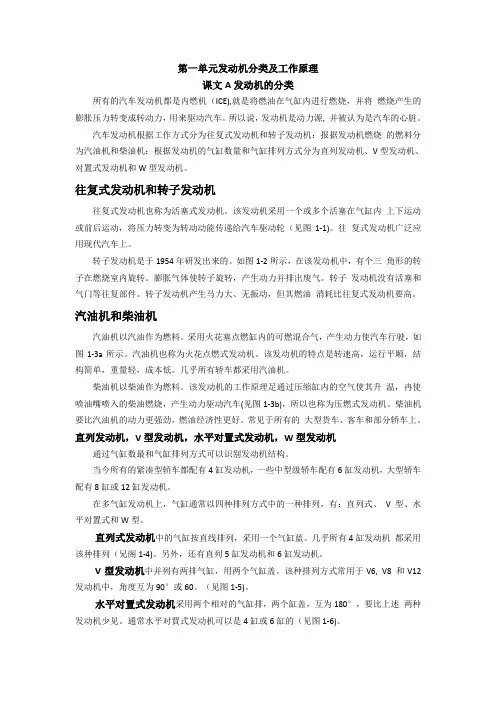
第一单元发动机分类及工作原理课文A发动机的分类所有的汽车发动机都是内燃机(ICE),就是将燃油在气缸内进行燃烧,并将燃烧产生的膨胀压力转变成转动力,用来驱动汽车。
所以说,发动机是动力源, 并被认为是汽车的心脏。
汽车发动机根据工作方式分为往复式发动机和转子发动机:报据发动机燃烧的燃料分为汽油机和柴油机:根据发动机的气缸数量和气缸排列方式分为直列发动机、V型发动机、对置式发动机和W型发动机。
往复式发动机和转子发动机往复式发动机也称为活塞式发动机。
该发动机采用一个或多个活塞在气缸内上下运动或前后运动,将压力转变为转动动能传递给汽车驱动轮(见图1-1)。
往复式发动机广泛应用现代汽车上。
转子发动机是于1954年研发出来的。
如图1-2所示,在该发动机中,有个三角形的转子在燃烧室内旋转。
膨胀气体使转子旋转,产生动力并排出废气。
转子发动机没有活塞和气门等往复部件。
转子发动机产生马力大、无振动,但其燃油消耗比往复式发动机要高。
汽油机和柴油机汽油机以汽油作为燃料。
采用火花塞点燃缸内的可燃混合气,产生动力使汽车行驶,如图1-3a所示。
汽油机也称为火花点燃式发动机。
该发动机的特点是转速高,运行平顺,结构简单,重量轻,成本低。
几乎所有轿车都采用汽油机。
柴油机以柴油作为燃料。
该发动机的工作原理足通过压缩缸内的空气使其升温,冉使喷油嘴喷入的柴油燃烧,产生动力驱动汽车(见图1-3b),所以也称为压燃式发动机。
柴油机要比汽油机的动力更强劲,燃油经济性更好。
常见于所有的大型货车、客车和部分轿车上。
直列发动机,V型发动机,水平对置式发动机,W型发动机通过气缸数最和气缸排列方式可以识别发动机结构。
当今所有的紧凑型轿车都配有4缸发动机,一些中型级轿车配有6缸发动机,大型轿车配有8缸或12缸发动机。
在多气缸发动机上,气缸通常以四种排列方式中的一种排列,有:直列式、V型、水平对置式和W型。
直列式发动机中的气缸按直线排列,采用一个气缸蓝。
几乎所有4缸发动机都采用该种排列(兄阁1-4)。
汽车专业英语课文翻译汽车专业英语是一门涵盖广泛的学科,它涵盖了汽车工程学、汽车设计学、汽车制造学、汽车维修学等多个领域。
学习汽车专业英语是非常有必要的,因为这是一个国际化的语言,同时也是在汽车行业工作所必要掌握的技能之一。
下面是一篇汽车专业英语课文,通过对其进行翻译,可以更好地理解其中的内容。
原文:Car Engine LubricationThe importance of lubrication in the engine of a car cannot be overemphasized. Without proper lubrication, the moving parts of anengine would grind agnst each other, causing unnecessary wear and tearon the engine and ultimately leading to its premature flure.Lubrication is accomplished by an oil pump that circulates oil throughout the engine. The oil serves as a lubricant between the moving parts, reducing friction and preventing metal-to-metal contact. The oil also acts as a cooling agent, carrying away heat generated by the engine.Oil filters are used to remove impurities from the oil, which can cause damage to the engine if not removed. Over time, the oil in an engine becomes contaminated and loses its viscosity, or thickness. It is important to regularly change the oil in a car to ensure that it continues to provide proper lubrication and cooling.Synthetic oils are becoming increasingly popular for use in car engines. Synthetic oils are engineered to provide superior lubrication and are more resistant to breaking down and losing their viscosity overtime. They also provide better protection agnst wear and tear and can improve fuel efficiency.Overall, proper lubrication is essential for the longevity and performance of a car engine. Regularly changing the oil and using high-quality synthetic oils can help to ensure that a car engine remns in top condition.译文:汽车发动机润滑汽车发动机的润滑问题不可忽视。
汽车特性参数汽车尺寸可以使你了解它的外观,包括轴距、前后轮距、全长、全宽、全高、前悬、后悬、接近角、离去角、内长、内宽、内高、离地距、整备质量、总质量、车门数、乘坐空间和后备箱空间。
汽车的性能是否优良取决于其发动机和底盘。
而发动机是否给力取决于它的类型、排量、压缩比、最大输出功率和扭矩。
更重要的是先进的行驶系、制动方式、传动系统和车轮组成坚固耐用的底盘。
发动机性能参数包括发动机类型,缸径和冲程,排量、压缩比、气门组、功率、扭矩和点火方式。
气缸的直径称作缸径。
排量和压缩比是发动机两个常用的参数,排量表明了发动机的大小,压缩比是汽缸总容积与燃烧室容积之比。
功率指的是正常工作时的速度。
有效功率是指在正常条件下在发动机后部测得的实际功率。
指示功率是理论功率,指的是在理想状态下由发动机获得的最大输出功率。
指示功率是由发动机大小、排量、转速和气缸内压力的基础上通过理论计算得到的。
摩擦功率指的是用来克服在发动机和传动系内的内部摩擦。
摩擦功率来源于轴承、活塞在气缸内滑动、压缩冲程、发电机、风扇、水泵、皮带、空调、变速器、后差速器总成等。
汽车驱动轮上获得的功率称为行驶功率。
扭矩是一种确定工况的方法,指的是扭转力。
扭转力产生于发动机的燃料燃烧。
燃烧将活塞向下推。
而活塞带动曲轴转动,产生扭矩。
而扭转力引起车轮的转动。
底盘的性能参数包括悬架类型,制动器的类型和大小,转向方式和转弯半径,车轮的型号与大小,油箱容积。
发动机工作原理大多数发动机都是内燃机,如图示为往复式四冲程汽油发动机。
但是其他类型的发动机也有使用,比如柴油发动机,转缸式发动机(汪克尔发动机),二冲程发动机和层状充气式发动机。
往复式的意思就是“从上到下”或“从后到前”。
在往复式发动机中动力产生于活塞的上下运动。
几乎所有这种类型的发动机都依赖于一个气缸体。
气缸是由铁或铝铸造出来的,在缸体内有气缸和水套,冷却水在水套内循环。
汽缸盖覆盖在缸体顶部,形成了燃烧室。
缸体底部被油底壳所包覆。
第1单元汽车基础课文A 汽车的基本组成今天的一般汽车含有15000多个相互独立的零件,这些零件必须相互配合才能工作。
这些零件可以被划分为四大类:发动机、车身、底盘和电气设备。
1.发动机发动机是汽车的动力装置。
内燃机是最常见的动力装置,它使燃料在气缸内燃烧,从而获得动力。
发动机有两种类型:汽油机(也叫做点燃式发动机)和柴油机(也叫做压燃式发动机)。
这两种发动机均被称为热机。
燃料的燃烧产生了热量,这将导致气缸内的气体压力的升高,从而带动与变速器相连接的一根轴旋转。
所有的发动机都设有燃料供给系统、排气系统、冷却系统和润滑系统。
汽油机还设有点火系统。
点火系统的作用是提供点燃气缸内的空气-燃油混合气必须的电火花。
当点火开关接通时,电流从12V蓄电池流到点火线圈。
点火线圈将电压提高,以便产生点燃燃料所必须的20000V的高电压。
汽车通过其电气系统提供它所需要的全部电流。
例如,汽车电气系统要为点火系统、喇叭、车灯、加热器和起动机提供电流。
电压的高低由充电系统来维持。
燃料系统贮存液体燃料,并将液体燃料输送给发动机。
燃料贮存在燃油箱内,燃油箱通过燃油管与燃油泵相连。
在燃油泵的作用下,将燃料从燃油箱吸上来,并通过燃油管,穿过滤清器,到达化油器(在这里,燃料与空气进行混合),或者进入燃油喷射系统。
燃料在化油器内、进气歧管内或者就在各个气缸内与空气混合,从而形成了可燃混合气。
冷却系统将多余的热量从发动机上搬走。
发动机燃烧室内的温度约为2000℉(1094℃)。
由于钢铁在大约2500℉(1354℃)时就会熔化,为了防止发动机损坏,必须将这些热量移走。
散热器内充满冷却液,水泵将使这些冷却液反复通过发动机气缸体和气缸盖内的空心薄壁层。
冷却液不停地流过发动机和散热器,从而将发动机的热量散发出去。
也可以通过散热器风扇将热量散发掉,因为风扇能使空气从散热器叶片的狭小缝隙中穿过。
冷却系统还能为乘客舱和车窗除霜器提供热量。
润滑系统对保持发动机平稳运转极为重要。
第一章汽车总论1)Today’s average car contains more than 15,000 separate, individual parts that must worktogether. These parts can be grouped into four major categories: body, engine, chassis and electrical equipment 。
P1现在的车辆一般都由15000多个分散、独立且相互配合的零部件组成。
这些零部件主要分为四类:车身、发动机、底盘和电气设备。
2)The engine acts as the power unit. The internal combustion engine is most common: thisobtains its power by burning a liquid fuel inside the engine cylinder. There are two types of engine: gasoline (also called a spark-ignition engine) and diesel (also called a compression-ignition engine). Both engines are called heat engines; the burning fuel generates heat which causes the gas inside the cylinder to increase its pressure and supply power to rotate a shaft connected to the power train. P3发动机作为动力设备,常见的类型是内燃机,其原理是通过发动机缸内的液体燃料燃烧而产生能量。
第1章一般信息1.1汽车的基本组成今天的一般汽车有15000多个必须相互配合才能工作的单个零件。
这些零件可分为四类:发动机、车身、底盘和电气设备,见图1-1.图1-1 汽车的基本组成发动机用作动力装置,有两种类型:汽油机(也叫做点燃式发动机)和柴油机(也叫做压燃式发动机)。
所有的发动机都有燃料供给系统、排气系统、冷却系统和润滑系统。
汽油机还有点火系统。
点火系统的作用是提供点燃缸内空气-燃油混合气所需要的电火花。
燃料供给系统的作用是存储液态燃料并将其供入发动机。
在化油器内,在进气歧管内或者在气缸内,燃料与空气混合,从而形成可燃混合气。
冷却系统的作用是从发动机上除去多余的热量。
利用空气和冷却液将热量带走。
润滑系统对于保持发动机平稳运转非常重要。
发动机油是润滑系统使用的润滑剂。
1.1.1 车身汽车车身(图1-2)对发动机、乘客和货物起保护作用。
车身的设计应保持乘客安全而舒适。
车身的造型应为车辆一个极具吸引力、鲜艳的、时髦的外表。
车身被制成流线型,以便减小空气阻力,并防止高速时汽车摆动。
图1-2 汽车车身1.1.3 底盘底盘包括传动系统、悬架系统、转向系统和制动系统。
传动系统包括离合器、变速器、传动轴、后桥与差速器以及驱动轮。
离合器或液力变矩器的任务是切断和连接发动机与汽车驱动轮之间的动力传递。
变速器的主要作用是在发动机与驱动轮之间提供一个传动比选择,从而使车辆在所有的行驶条件下都能够满意地工作。
档位的选择可以由驾驶员手动进行,或者靠液压系统自动选择。
传动轴的作用是将动力从变速器传递给后桥-差速器总成的输入轴。
柔性接头允许后桥和后轮上下运动,却不会影响工作。
后桥-差速器总成将发动机旋转动力的传递方向改变90度,从传动轴传到后桥,再到后轮。
它的另一个作用是让每个驱动轮以不同的转速转动。
第三个作用是引入一个传动比,对转矩进行放大。
悬架系统的基本作用是吸收路面凹凸不平所引起的冲击(否则的话,这些冲击将会传递给车辆及其乘客),因此,不管道路条件怎样恶劣,有助于将车辆保持在可控制的笔直的路线上。
Engine Classification引擎分类The engines can be classified in the following several ways: (1) operating cycle, (2) piston action, (3) piston connection, (4) cylinder arrangement, (5) method of fuel injection, and (6) speed.这个引擎可以分为以下几个方面:(1)操作周期,(2)活塞行动,(3)活塞连接,(4)缸安排,(5)方法的燃油喷射,(6)的速度。
Operating cycle. Diesel and gas-burning engines can be divided into two groups based on the number of piston strokes per cycle, either four or two. An engine which needs four strokes to complete one cycle is a four-stroke cycle engine or, for short, a four-cycle engine (Fig.3). If it needs only two strokes to complete a cycle, it is called a two-stroke cycle engine or, for short, a two-cycle engine. Thus, a two-cycle engine fires twics as often as a four-cycle engine.操作周期。
柴油和燃气发动机可以分为两组基于数量的活塞的划水循环,或者四个或两个。
一个引擎,需要完成一个周期的四种泳姿是四冲程循环发动机或、短,一个四冲程引擎(图3)。